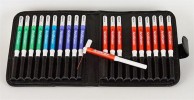Authors
T. Schwedt, R. Gereau 4th, K. Frey, E. Kharasch.
Lab
Washington University School of Medicine, USA. schwedtt@neuro.wustl.edu
Journal
Cephalagia
Abstract
OBJECTIVE: To analyze headache patterns prior to and following treatment of unruptured intracranial aneurysms and identify factors associated with different headache outcomes. METHODS: A prospective observational study of patients being treated for unruptured intracranial aneurysms. Headache patterns were established prior to aneurysm treatment and for 6 months following treatment. Factors associated with different headache outcomes were investigated. RESULTS: In all patients (n_=_44), 90-day headache frequency decreased from an average of 31 days prior to aneurysm treatment to 17 days following treatment (p_<_0.001). In patients with active pretreatment headaches (n_=_28), 90-day headache frequency decreased from 49 days to 26 days (p_=_0.002). Headache frequency was reduced in 68% of patients, while 9% of patients had new or worsened headaches following aneurysm treatment. Pretreatment migraine, more severe pretreatment headaches, higher pretreatment trait anxiety, and stent-assisted aneurysm coiling were associated with a lack of headache improvement. CONCLUSIONS: The majority of patients with headaches at the time of aneurysm treatment had reductions in headache frequency during the 6 months following treatment. Potential risk factors for poor headache outcomes were identified but need to be studied further.
BIOSEB Instruments Used:
Von Frey Filaments (Bio-VF-M)

 Pain - Thermal Allodynia / Hyperalgesia
Pain - Thermal Allodynia / Hyperalgesia Pain - Spontaneous Pain - Postural Deficit
Pain - Spontaneous Pain - Postural Deficit Pain - Mechanical Allodynia / Hyperalgesia
Pain - Mechanical Allodynia / Hyperalgesia Learning/Memory - Attention - Addiction
Learning/Memory - Attention - Addiction Physiology & Respiratory Research
Physiology & Respiratory Research
 Pain
Pain Central Nervous System (CNS)
Central Nervous System (CNS) Neurodegeneration
Neurodegeneration Sensory system
Sensory system Motor control
Motor control Mood Disorders
Mood Disorders Other disorders
Other disorders Muscular system
Muscular system Joints
Joints Metabolism
Metabolism Cross-disciplinary subjects
Cross-disciplinary subjects Happy new year 2025
Happy new year 2025 